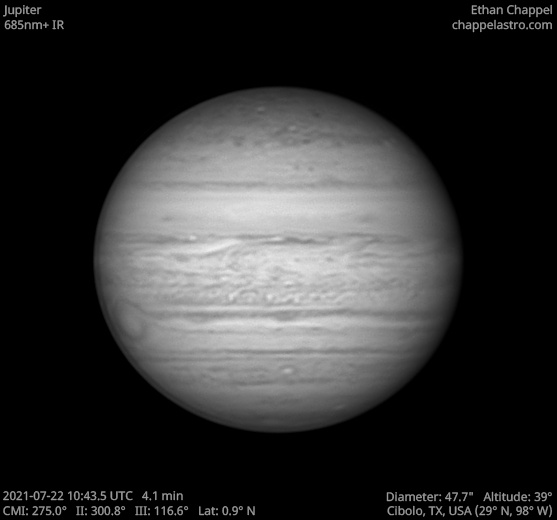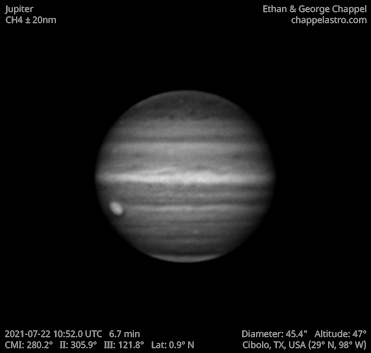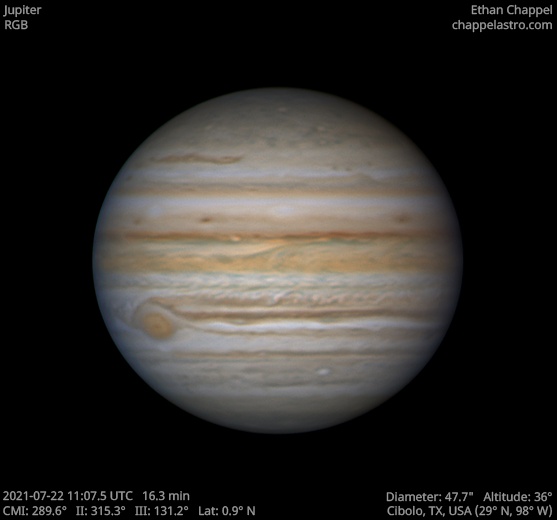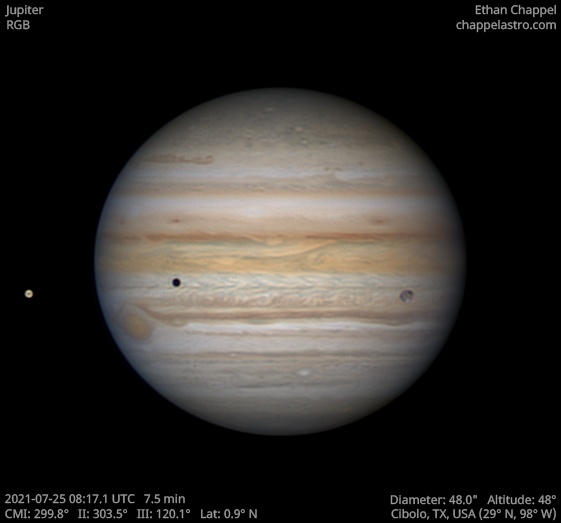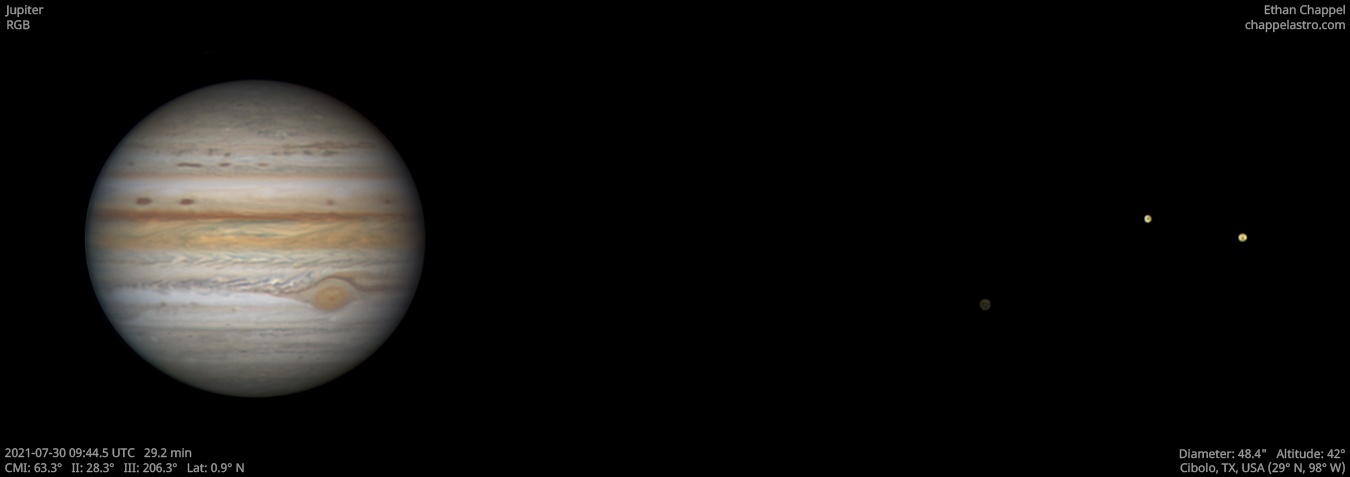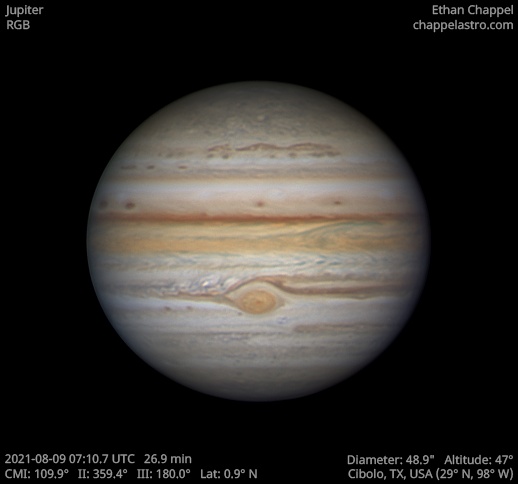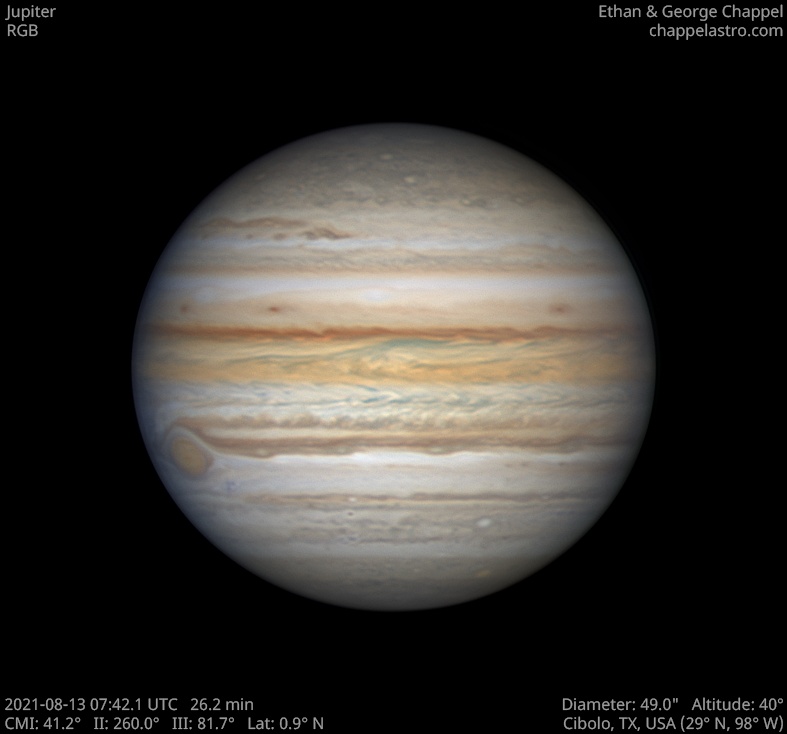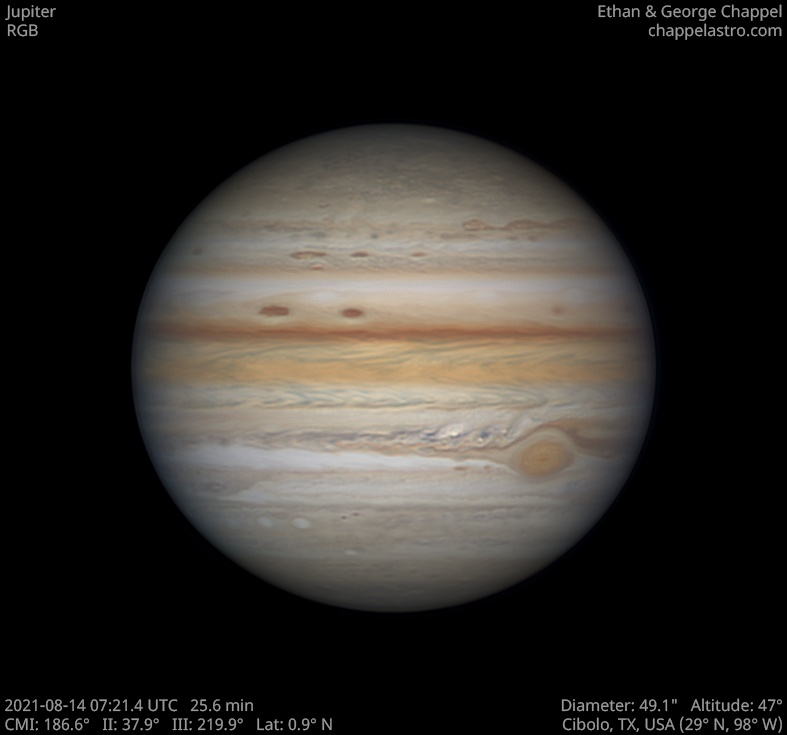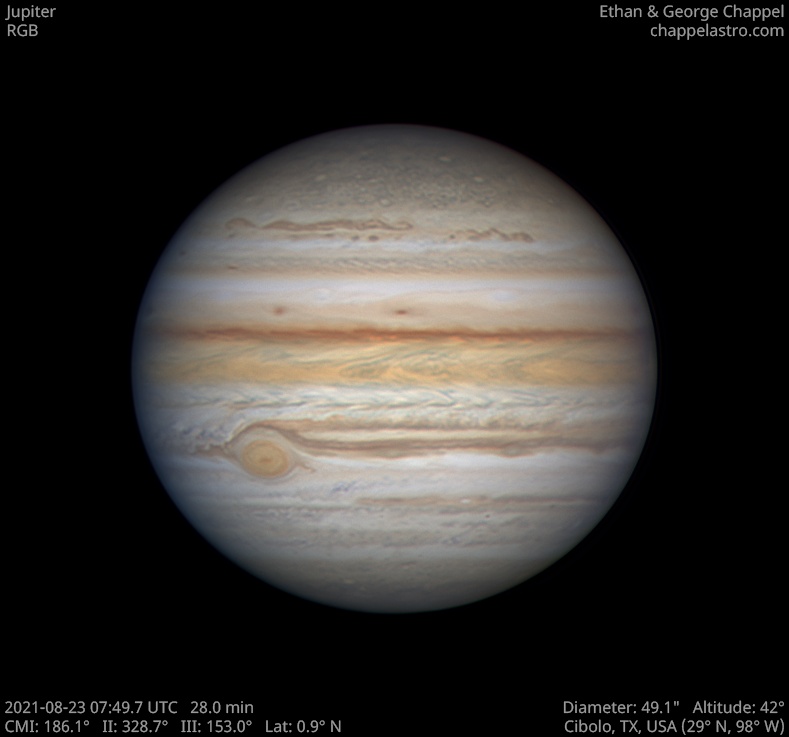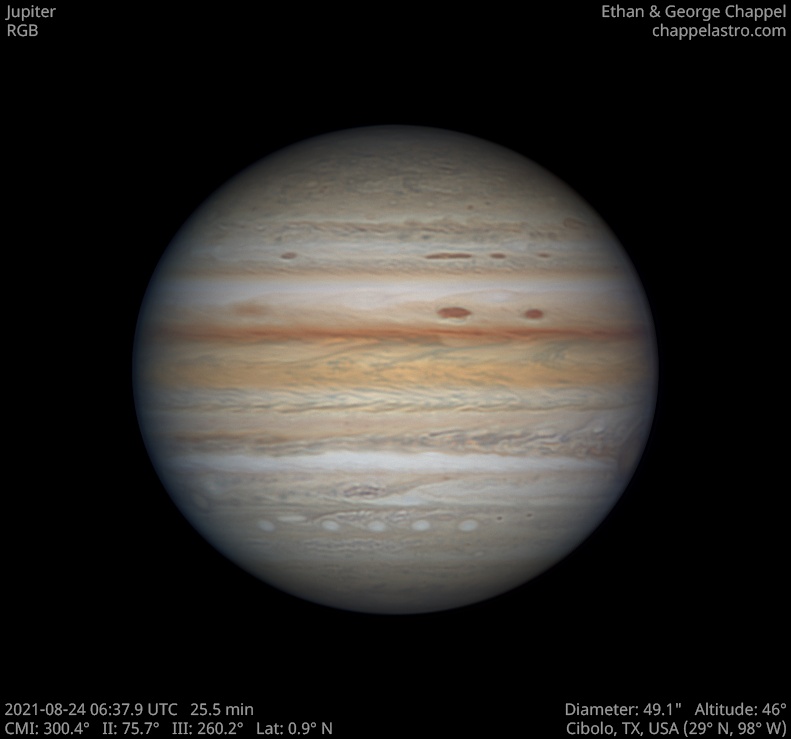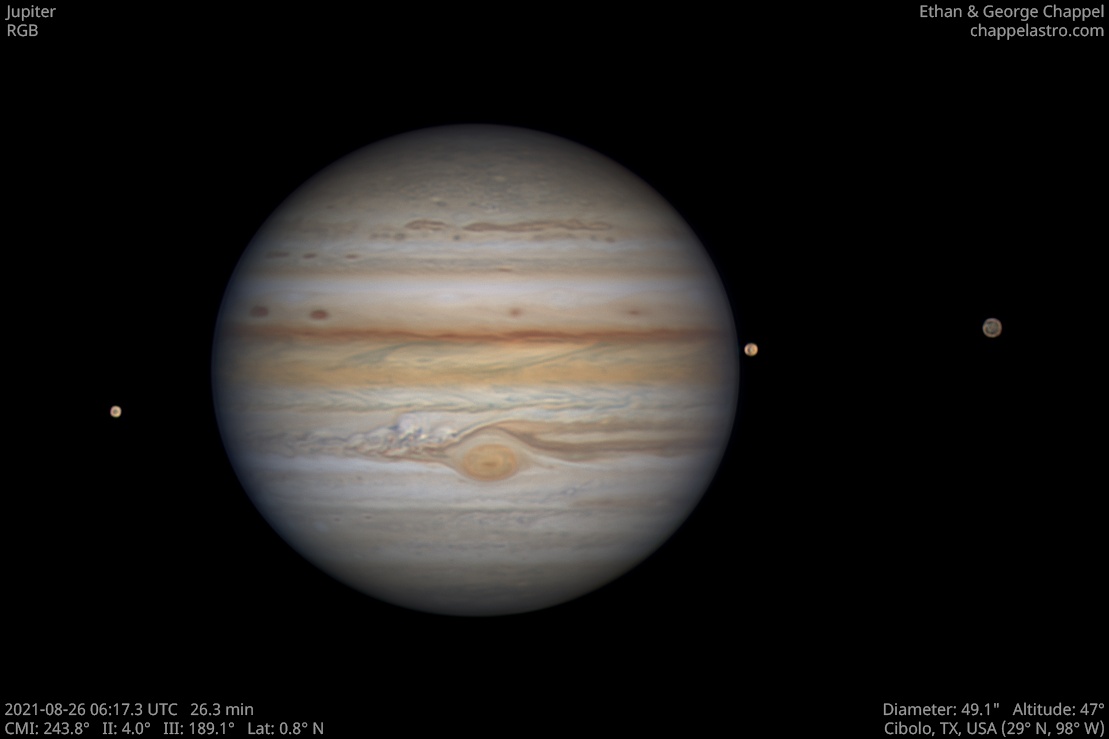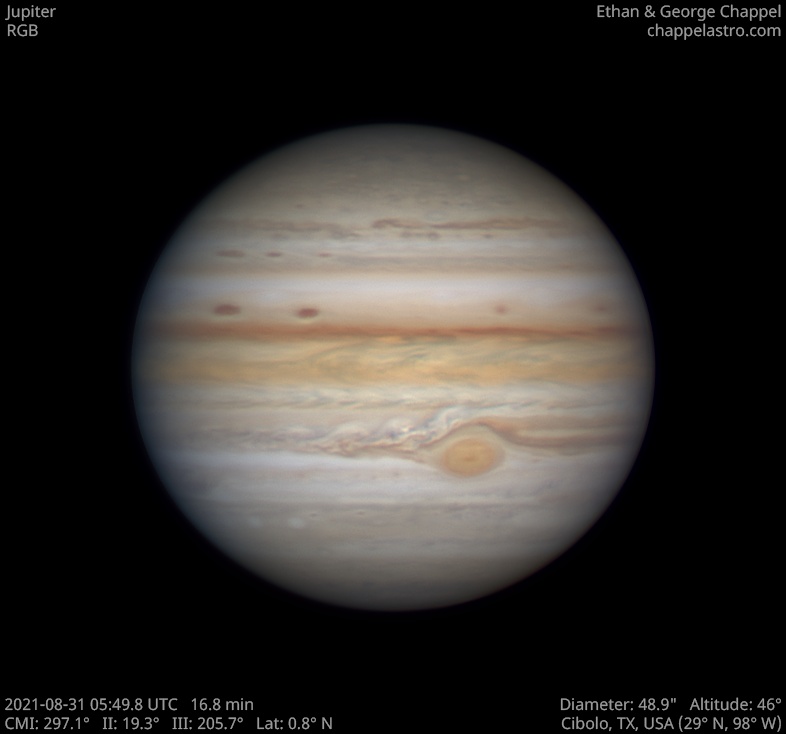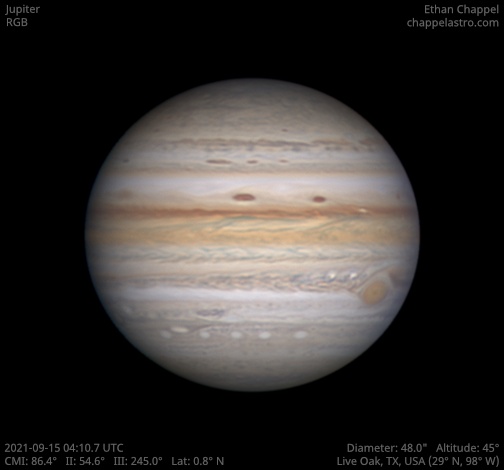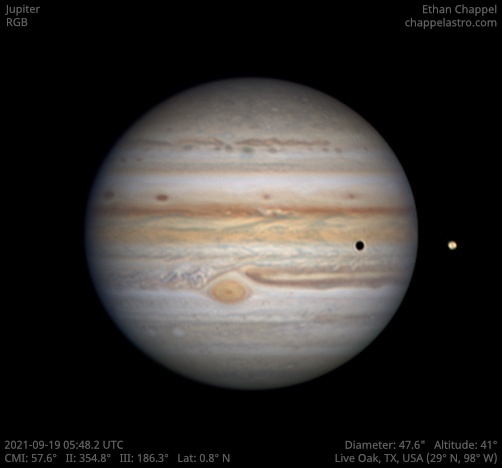Jupiter 2021
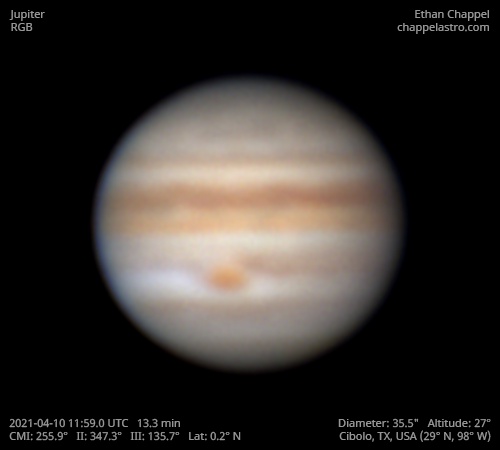
UTC
Although Jupiter has been visible in the morning sky for a while now, the wait for clear weather has finally ended. As the sky brightened, it was breezy and the air above was very turbulent. This was my first time having insulation wrapped around the OTA while imaging a planet. Despite having just bringing the scope out to a cooler environment, I saw no internal heat plume while collimating the secondary mirror.
This was also the first time I used my Chroma extended green filter on Jupiter. As expected, the new filter gave a brighter image compared to the standard green. The 11:59 image uses the standard green filter while the 12:00 image uses the extended green. I am hoping for better conditions soon so I can create a solid comparison between both filters.
The Equatorial Zone is still orange like it has been for the past 3 apparitions. The North Equatorial Belt is noticeably darker than the South Equatorial Belt.

UTC
Although Jupiter has been visible in the morning sky for a while now, the wait for clear weather has finally ended. As the sky brightened, it was breezy and the air above was very turbulent. This was my first time having insulation wrapped around the OTA while imaging a planet. Despite having just bringing the scope out to a cooler environment, I saw no internal heat plume while collimating the secondary mirror.
This was also the first time I used my Chroma extended green filter on Jupiter. As expected, the new filter gave a brighter image compared to the standard green. The 11:59 image uses the standard green filter while the 12:00 image uses the extended green. I am hoping for better conditions soon so I can create a solid comparison between both filters.
The Equatorial Zone is still orange like it has been for the past 3 apparitions. The North Equatorial Belt is noticeably darker than the South Equatorial Belt.
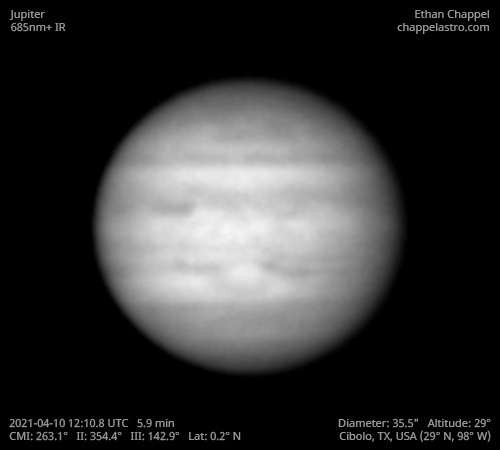
UTC
Although Jupiter has been visible in the morning sky for a while now, the wait for clear weather has finally ended. As the sky brightened, it was breezy and the air above was very turbulent. This was my first time having insulation wrapped around the OTA while imaging a planet. Despite having just bringing the scope out to a cooler environment, I saw no internal heat plume while collimating the secondary mirror.
This was also the first time I used my Chroma extended green filter on Jupiter. As expected, the new filter gave a brighter image compared to the standard green. The 11:59 image uses the standard green filter while the 12:00 image uses the extended green. I am hoping for better conditions soon so I can create a solid comparison between both filters.
The Equatorial Zone is still orange like it has been for the past 3 apparitions. The North Equatorial Belt is noticeably darker than the South Equatorial Belt.
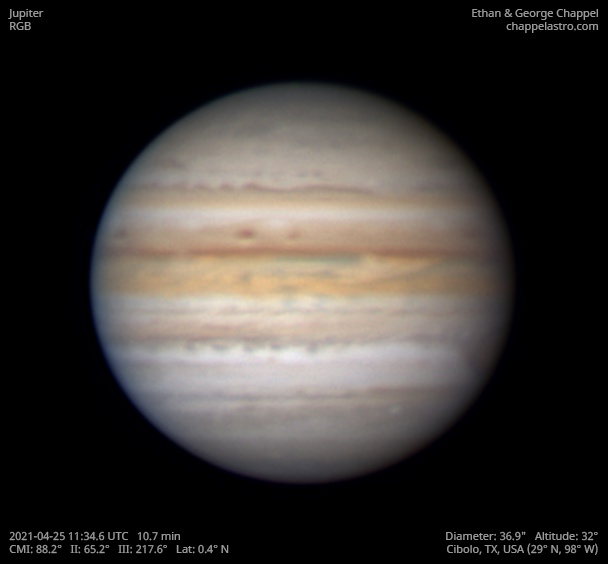
UTC
Sky conditions were significantly better than two weeks ago. Jupiter is now reaching 30 degrees high while it is dark enough to image. It will transit 47 degrees from my location this apparition, about 9 degrees higher than last year.
The North and South Equatorial Belt both appear faded, except for the southern edge of the NEB. The Equatorial Zone is intensely orange. The Great Red Spot is setting on the right.
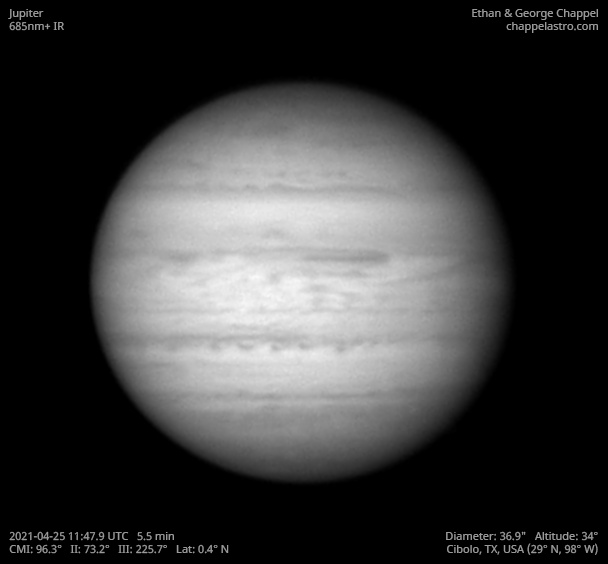
UTC
Sky conditions were significantly better than two weeks ago. Jupiter is now reaching 30 degrees high while it is dark enough to image. It will transit 47 degrees from my location this apparition, about 9 degrees higher than last year.
The North and South Equatorial Belt both appear faded, except for the southern edge of the NEB. The Equatorial Zone is intensely orange. The Great Red Spot is setting on the right.
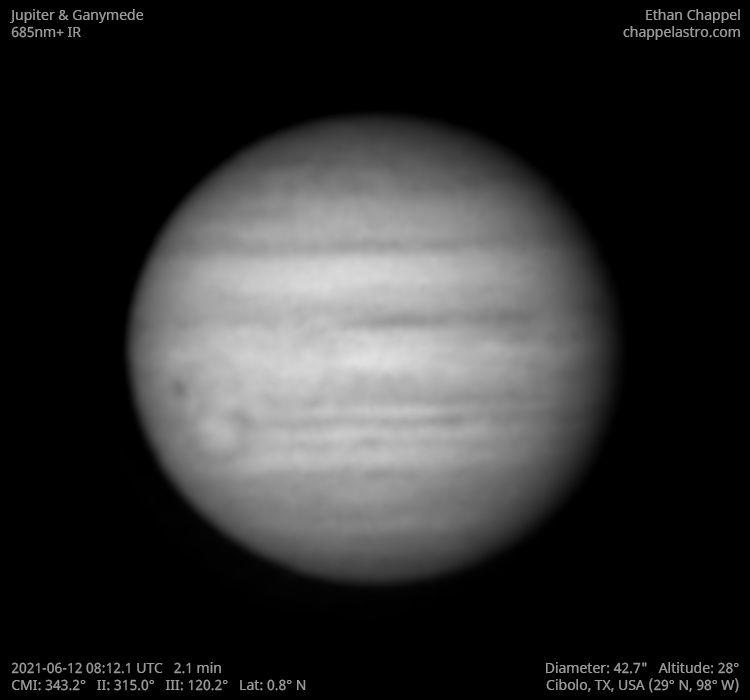
UTC
Clouds were rolling in while recording, limiting the image's resolution. This was the first night with my new Sky-Watcher EQ6-R Pro. While my primary use for this mount will be for deep sky imaging, it will also let me use the EdgeHD 11 in times I would have used the EdgeHD 8 for planetary imaging.
Notes:
- The Great Red Spot is rotating into view.
- Ganymede is transiting over the planet northeast of the GRS.
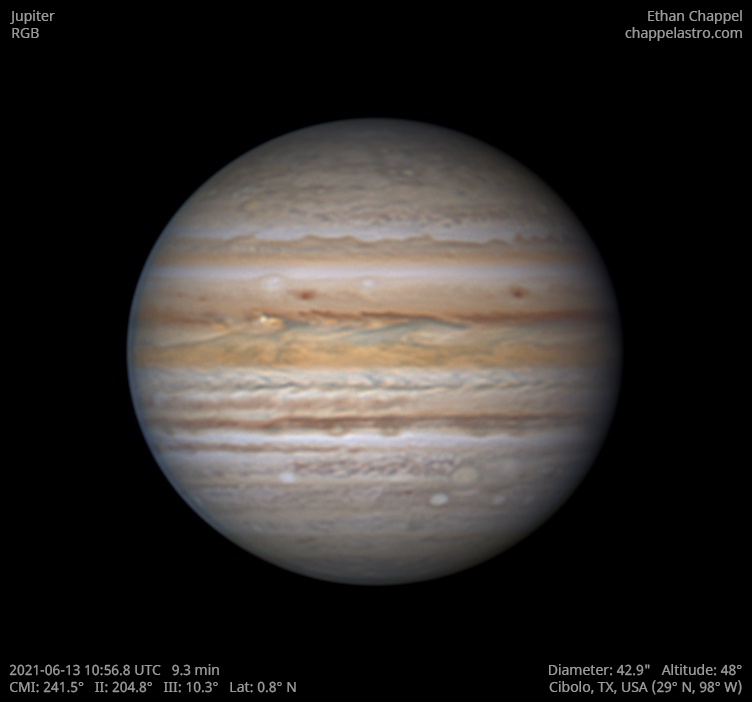
UTC
Excellent seeing conditions. This is a second attempt with my EdgeHD 11 and new Sky-Watcher EQ6-R Pro after a near-failure the previous morning because of clouds. My primary use for this mount will be for deep sky imaging, but I can also use it for planetary imaging with the EdgeHD 11 in times I would've used the EdgeHD 8 and Advanced VX.
Notes:
- Both the North & South Equatorial Belts appear faded except for their southern edges.
- The Equatorial Zone, except for the southern edge, is still orange.
- Oval BA has a slight orange color.
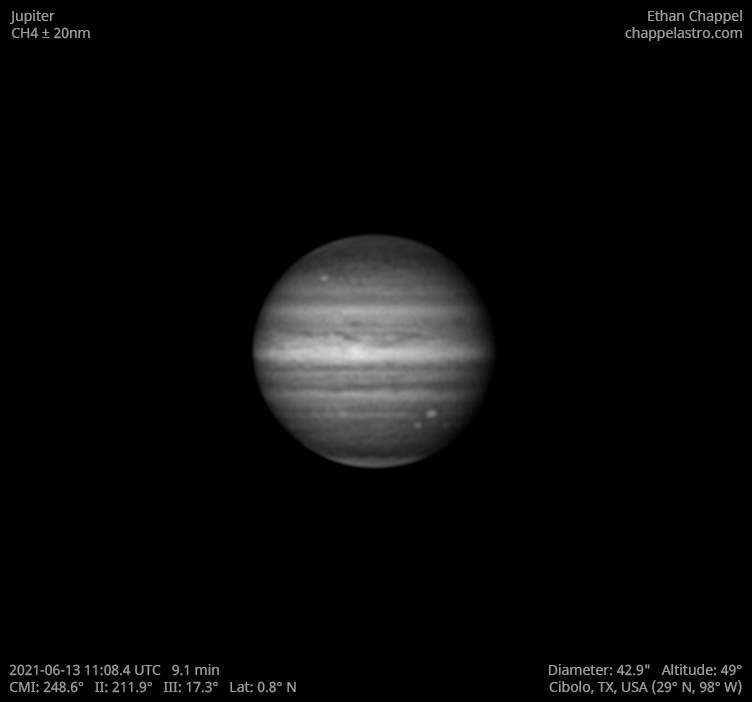
UTC
Excellent seeing conditions. This is a second attempt with my EdgeHD 11 and new Sky-Watcher EQ6-R Pro after a near-failure the previous morning because of clouds. My primary use for this mount will be for deep sky imaging, but I can also use it for planetary imaging with the EdgeHD 11 in times I would've used the EdgeHD 8 and Advanced VX.
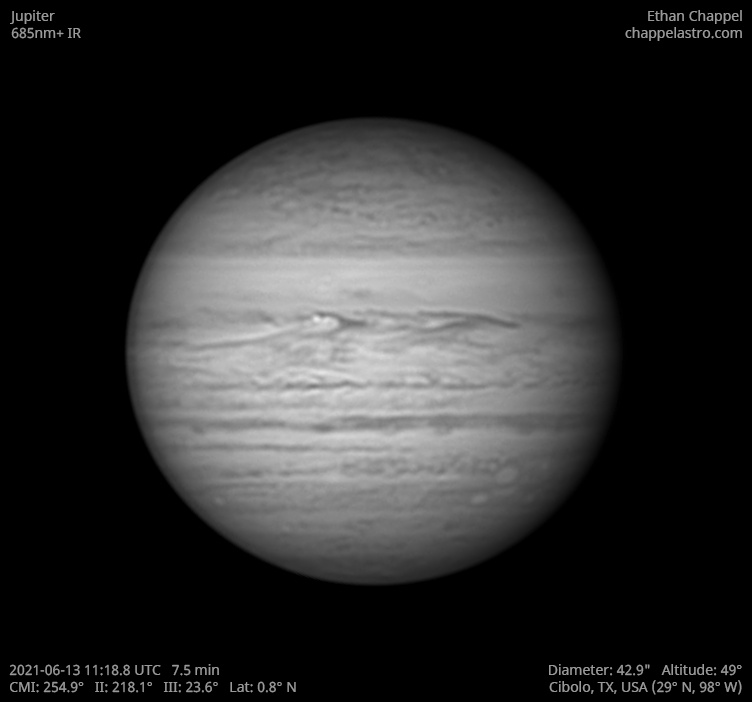
UTC
Excellent seeing conditions. This is a second attempt with my EdgeHD 11 and new Sky-Watcher EQ6-R Pro after a near-failure the previous morning because of clouds. My primary use for this mount will be for deep sky imaging, but I can also use it for planetary imaging with the EdgeHD 11 in times I would've used the EdgeHD 8 and Advanced VX.

UTC
Good seeing on June 14th. The Great Red Spot is nearly at the central meridian. Compared to the last few years, the storm's color is less intense. The North Equatorial Belt also appears to be fading, except for the southern edge.
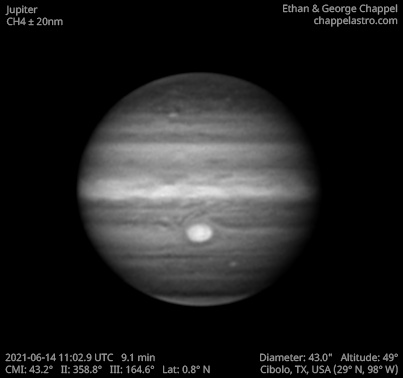
UTC
Good seeing on June 14th. The Great Red Spot is nearly at the central meridian. Compared to the last few years, the storm's color is less intense. The North Equatorial Belt also appears to be fading, except for the southern edge.
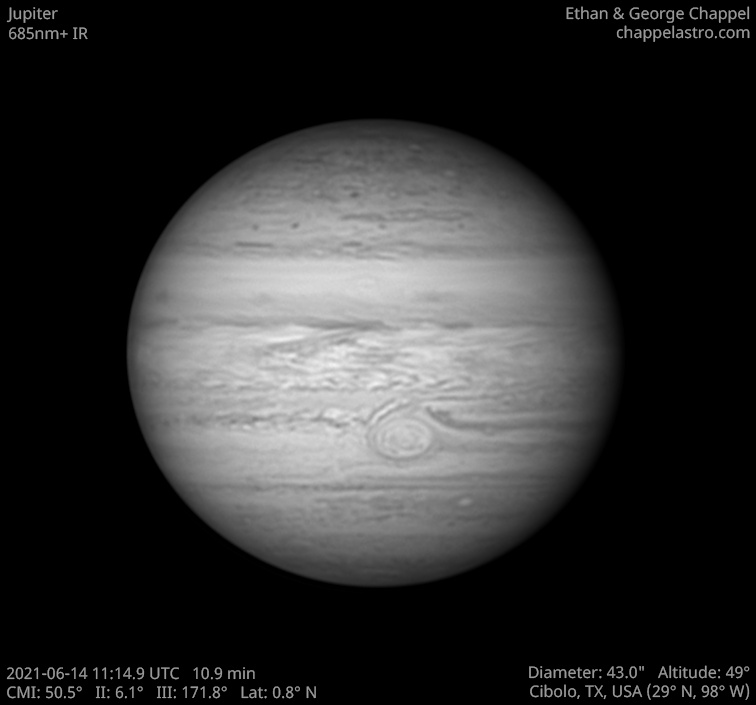
UTC
Good seeing on June 14th. The Great Red Spot is nearly at the central meridian. Compared to the last few years, the storm's color is less intense. The North Equatorial Belt also appears to be fading, except for the southern edge.

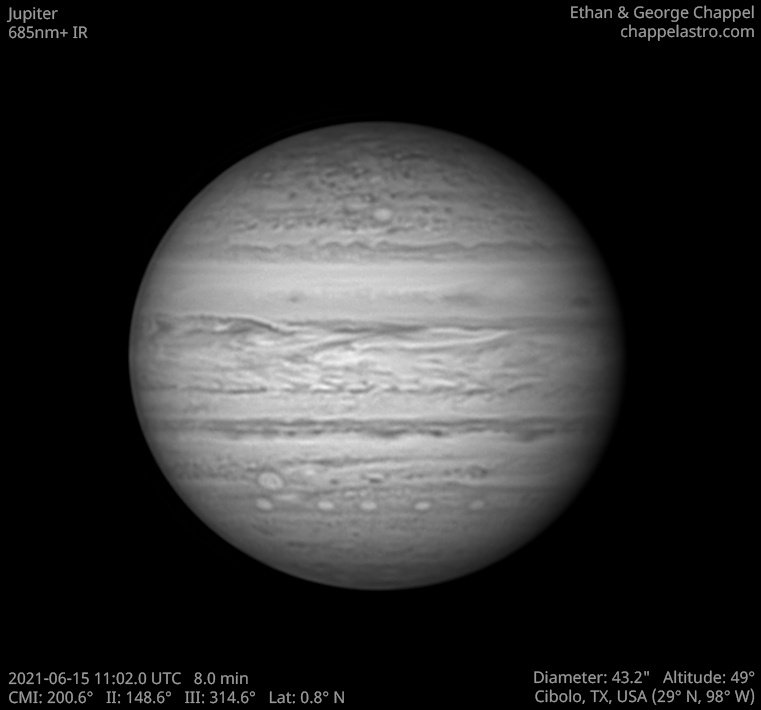
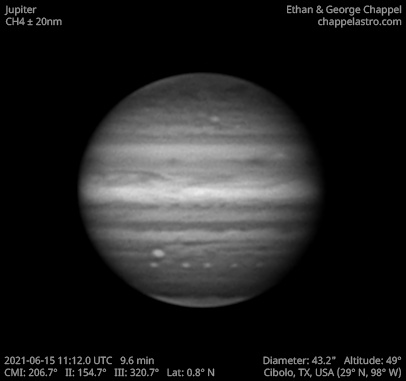
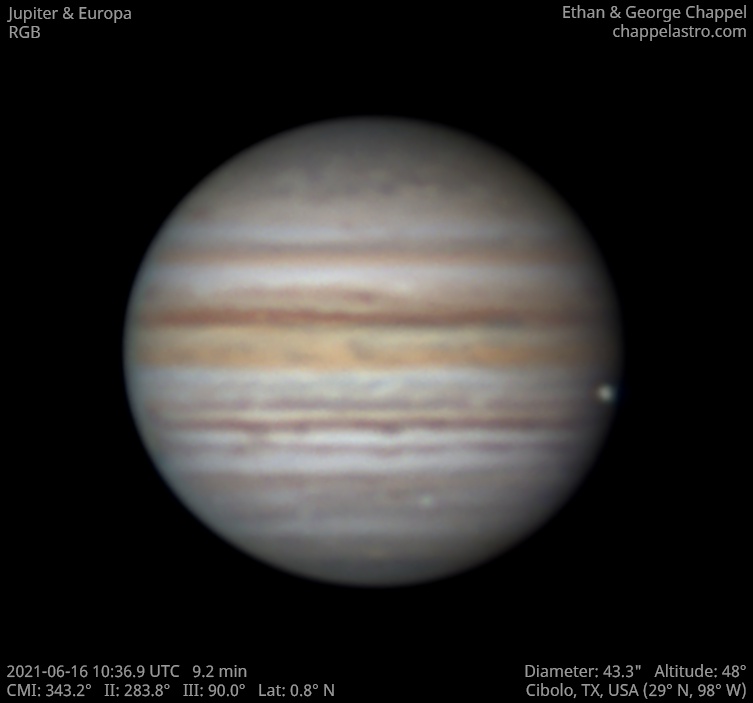

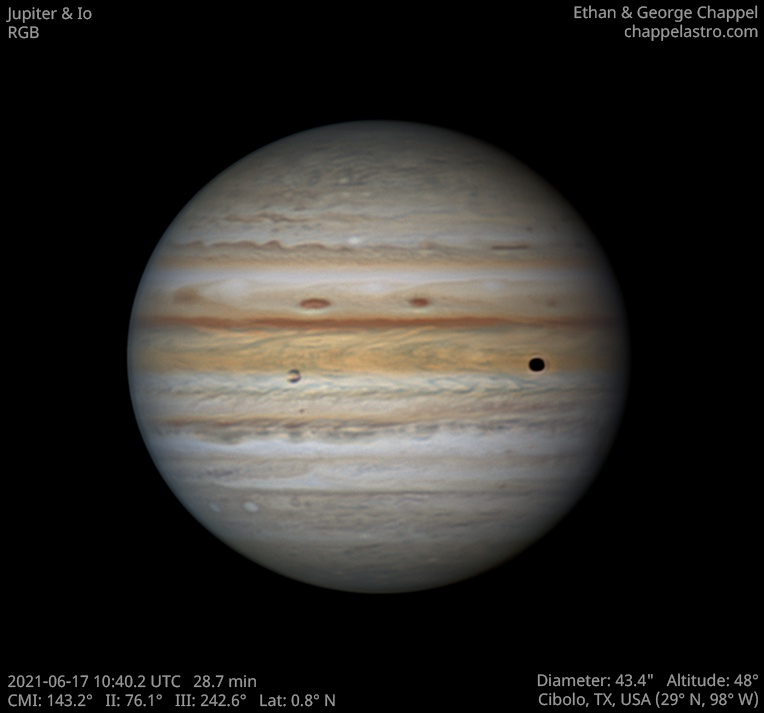
UTC
Very good seeing on June 17th. After expanding north last year, the North Equatorial Belt is fading except for the southern edge. In contrast, the typically white Equatorial Zone is still mostly orange for the fourth consecutive year. Io and its shadow are transiting across the EZ.

UTC
Very good seeing on June 17th. After expanding north last year, the North Equatorial Belt is fading except for the southern edge. In contrast, the typically white Equatorial Zone is still mostly orange for the fourth consecutive year. Io and its shadow are transiting across the EZ.
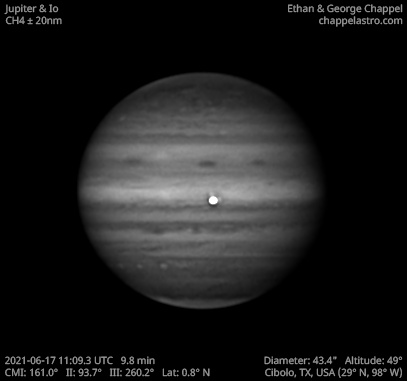
UTC
Very good seeing on June 17th. After expanding north last year, the North Equatorial Belt is fading except for the southern edge. In contrast, the typically white Equatorial Zone is still mostly orange for the fourth consecutive year. Io and its shadow are transiting across the EZ.
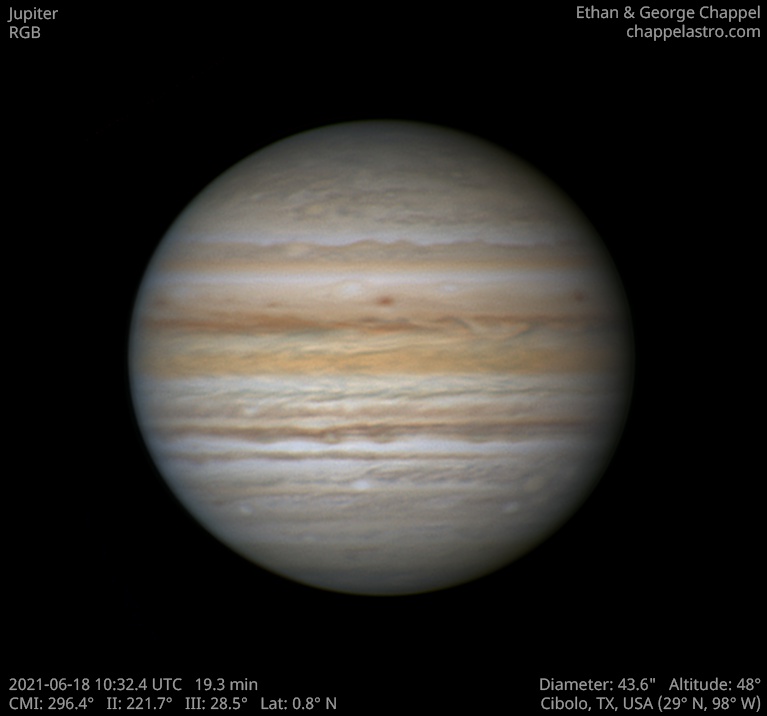
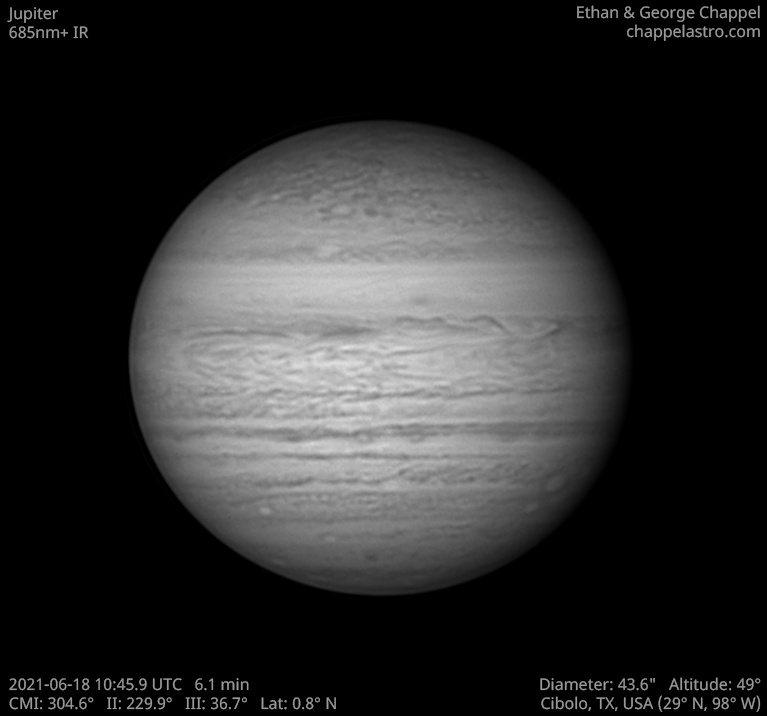

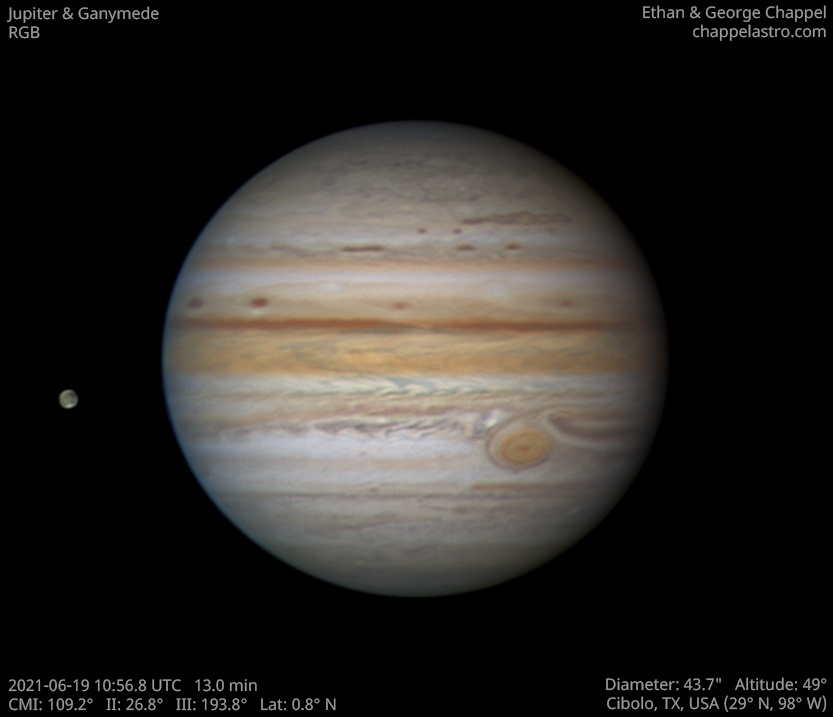
UTC
Good seeing on June 19th, 2021.
The Great Red Spot has an orange color that is less intense than last year. Dark clouds from the South Equatorial Belt were pulled around the giant storm and eastward winds in the South Tropical Zone picked them up to form a long tail behind the storm.
The North Equatorial Belt is fading, leaving a thin band of dark clouds on the southern edge. The Equatorial Zone is orange, nearly the same color as the GRS.
Ganymede is approaching transit. Osiris can be seen on the southern hemisphere as a bright spot and Galileo Regio can be seen as a dark patch on the northeast limb.
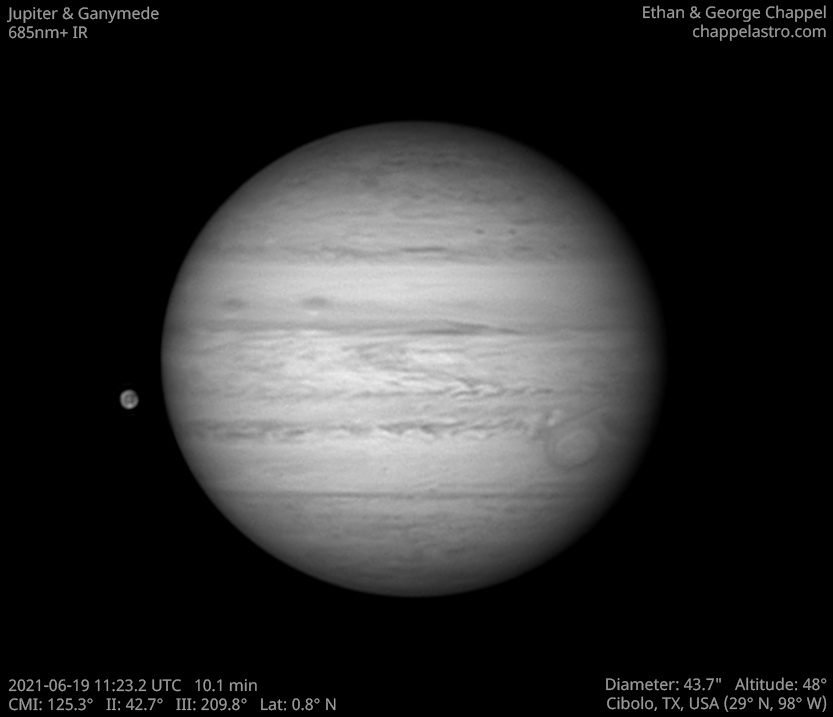
UTC
Good seeing on June 19th, 2021.
The Great Red Spot has an orange color that is less intense than last year. Dark clouds from the South Equatorial Belt were pulled around the giant storm and eastward winds in the South Tropical Zone picked them up to form a long tail behind the storm.
The North Equatorial Belt is fading, leaving a thin band of dark clouds on the southern edge. The Equatorial Zone is orange, nearly the same color as the GRS.
Ganymede is approaching transit. Osiris can be seen on the southern hemisphere as a bright spot and Galileo Regio can be seen as a dark patch on the northeast limb.
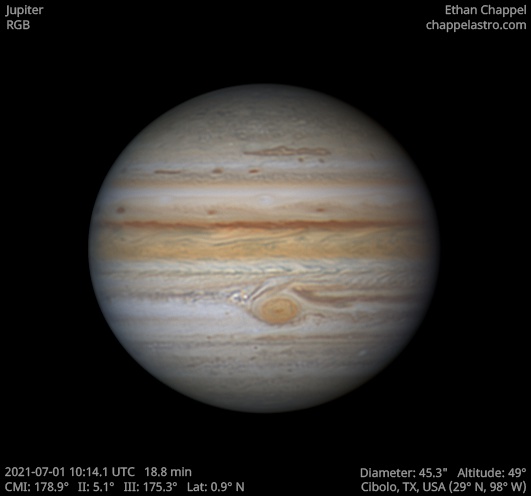
UTC
An unexpected yet excellent night of planetary imaging. This night is probably about as good as I can get with the EdgeHD 11.
The faded portion of the North Equatorial Belt contains a few brown barges remaining from last year's northward expansion of the belt.
The Great Red spot has some fine detail visible. A few fresh outbreaks are visible in the wake ahead of it.
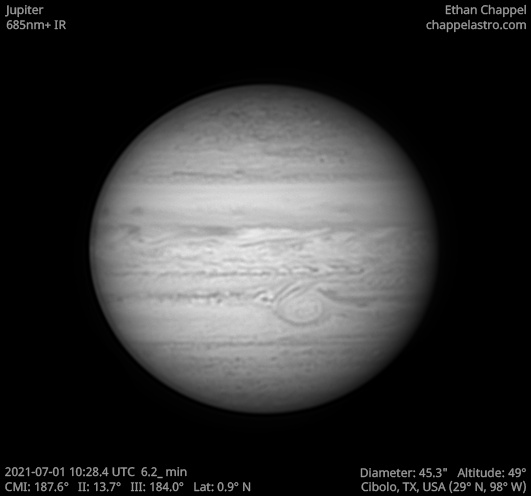
UTC
An unexpected yet excellent night of planetary imaging. This night is probably about as good as I can get with the EdgeHD 11.
The faded portion of the North Equatorial Belt contains a few brown barges remaining from last year's northward expansion of the belt.
The Great Red spot has some fine detail visible. A few fresh outbreaks are visible in the wake ahead of it.
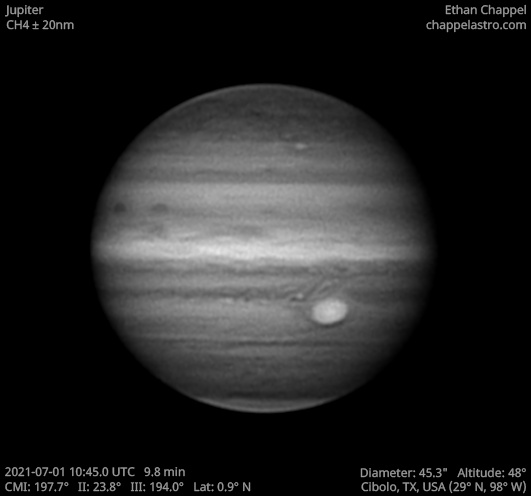
UTC
An unexpected yet excellent night of planetary imaging. This night is probably about as good as I can get with the EdgeHD 11.
The faded portion of the North Equatorial Belt contains a few brown barges remaining from last year's northward expansion of the belt.
The Great Red spot has some fine detail visible. A few fresh outbreaks are visible in the wake ahead of it.

UTC
A beautiful night with excellent seeing July 2, 2021. We were prepared this time and took out the EdgeHD 14 to take high resolution images of Jupiter.
The North Equatorial Belt, or NEB for short, is the most prominent belt in the northern hemisphere of Jupiter. It typically spans from 9 to 17 degrees north of the equator, but the northern edge will occasionally push into the neighboring North Tropical Zone until it reaches 21 degrees north. When this happens, the belt is in an expanded state and usually stays that way for about one Earth year.
When the belt expands northward, two types of storms will emerge from the turbulence: anticyclonic white spots and cyclonic brown barges. Both types of storms will disappear once the NEB recedes southward. One notable exception is known as White Spot Z, which has persisted in the region since 1997.
The NEB is currently receding after an expansion event in 2020. This time, the new northern edge appears to be at 12 degrees north. Northward expansions following these unusually far receding events are typically much more vigorous than typical expansion events, so we may be in for an exciting show anytime from 2023-2025 if this follows the same pattern.
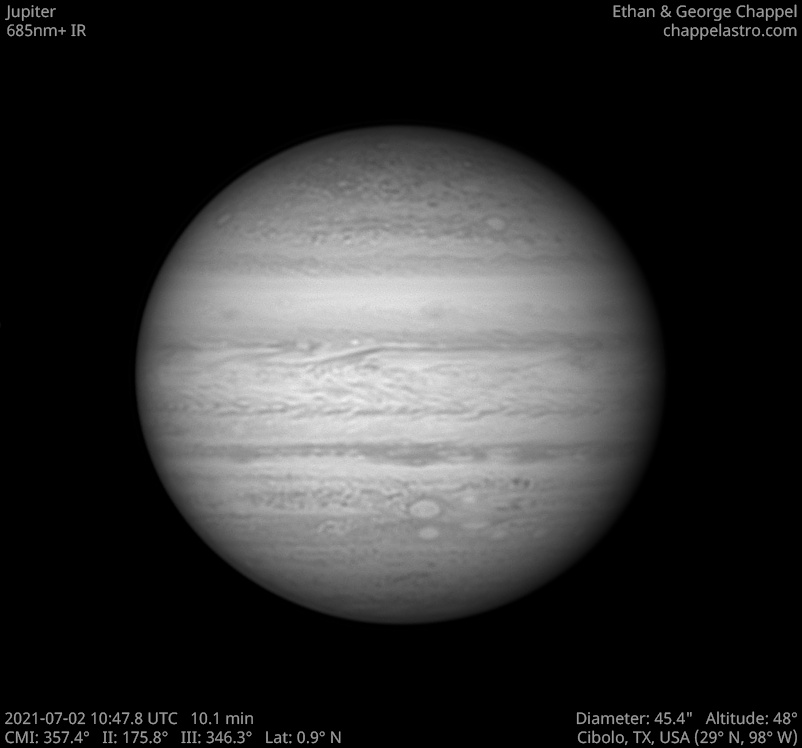
UTC
A beautiful night with excellent seeing July 2, 2021. We were prepared this time and took out the EdgeHD 14 to take high resolution images of Jupiter.
The North Equatorial Belt, or NEB for short, is the most prominent belt in the northern hemisphere of Jupiter. It typically spans from 9 to 17 degrees north of the equator, but the northern edge will occasionally push into the neighboring North Tropical Zone until it reaches 21 degrees north. When this happens, the belt is in an expanded state and usually stays that way for about one Earth year.
When the belt expands northward, two types of storms will emerge from the turbulence: anticyclonic white spots and cyclonic brown barges. Both types of storms will disappear once the NEB recedes southward. One notable exception is known as White Spot Z, which has persisted in the region since 1997.
The NEB is currently receding after an expansion event in 2020. This time, the new northern edge appears to be at 12 degrees north. Northward expansions following these unusually far receding events are typically much more vigorous than typical expansion events, so we may be in for an exciting show anytime from 2023-2025 if this follows the same pattern.
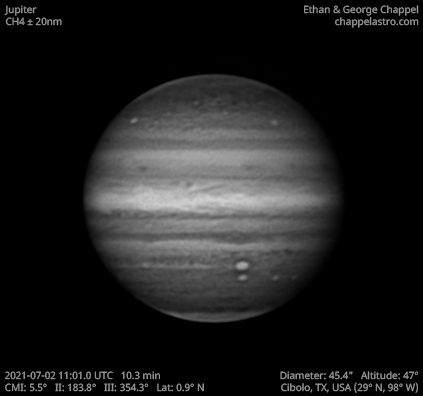
UTC
A beautiful night with excellent seeing July 2, 2021. We were prepared this time and took out the EdgeHD 14 to take high resolution images of Jupiter.
The North Equatorial Belt, or NEB for short, is the most prominent belt in the northern hemisphere of Jupiter. It typically spans from 9 to 17 degrees north of the equator, but the northern edge will occasionally push into the neighboring North Tropical Zone until it reaches 21 degrees north. When this happens, the belt is in an expanded state and usually stays that way for about one Earth year.
When the belt expands northward, two types of storms will emerge from the turbulence: anticyclonic white spots and cyclonic brown barges. Both types of storms will disappear once the NEB recedes southward. One notable exception is known as White Spot Z, which has persisted in the region since 1997.
The NEB is currently receding after an expansion event in 2020. This time, the new northern edge appears to be at 12 degrees north. Northward expansions following these unusually far receding events are typically much more vigorous than typical expansion events, so we may be in for an exciting show anytime from 2023-2025 if this follows the same pattern.

